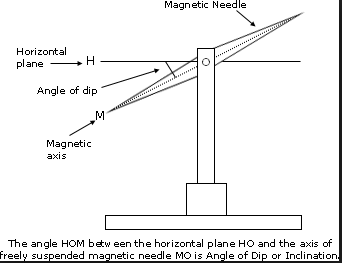Angle of dip is defined as that angle which the direction of total strength of earth's magnetic field makes with a horizontal line in magnetic meridian. It is represented by .
Let,
Be be the Earth's magnetic field,
is the angle of dip.
V is the vertical component of earth's magnetic field.
H is the horizontal component of earth's magnetic field
Now, resolving Be along horizontal and vertical direction we get,
cos =
which, is the required relation.
Properties:
1. Diamagnetic :
i) magnetic susceptibilty is independent of temperature.
ii) magnetic permeability has value less than 1.
iii) repelled by a strong magnet.
2. Paramagnetic:
i) magnetic susceptibility decreases with rise of temperature.
ii) magnetic permeabilty has value slightly greater than 1.
iii) attracted by a strong magnet.
3. Ferromagnetic:
i) magnetic susceptibility decreases with increase in temperature.
ii) magnetic permeabilty is very large.
iii) highly attracted by a strong magnet.
When horizontal component BH is equal to vertical component BV of Earth's magnetic field then,
where, is the angle of dip.
Magnetic elements of earth at a place are the quantities which describe completely in in magnitude as well as direction, the magnetic field of earth at that place.
The three magnetic elements of earth are:
1. Magnetic declination ( )
2. Magnetic inclination or magnetic dip (), and
3. Horizontal component (H). 
Bring both the bars closer to each other and, if in case there is repulsion in between the bars, then both bars are magnetised. If the bars get attracted to each other, then only 1 bar is magnetised.
To identify which bar is bar magnet:
Lay bar A on the table and hold bar B in your hand with it's one end placed in the middle of bar A. If the bars tend to get attracted then we can say that bar B (in hand) is magnetised and is the bar magnet.
